Translating Your Auto'S Alert Lights: Their Real Effects
Translating Your Auto'S Alert Lights: Their Real Effects
Blog Article
Web Content Writer-Faulkner Dalgaard
When you're behind the wheel, those glowing caution lights on your dashboard can be a bit perplexing. Do you understand what they're attempting to tell you concerning your cars and truck's health and wellness? Understanding ceramic wash of these lights is crucial for your safety and the longevity of your automobile. So, the next time one of those lights pops up, wouldn't you wish to understand its message properly and take the needed actions to resolve it?
Common Warning Lights and Interpretations
Identify typical caution lights in your automobile and comprehend their definitions to ensure safe driving.
The most regular caution lights consist of the check engine light, which signals problems with the engine or exhausts system. If carwashdetailingauckland comes on, it's vital to have your lorry examined without delay.
The oil pressure cautioning light shows reduced oil stress, needing instant interest to prevent engine damages.
A blinking battery light might recommend a damaged charging system, potentially leaving you stranded otherwise attended to.
The tire pressure monitoring system (TPMS) light notifies you to reduced tire stress, impacting automobile security and gas effectiveness. Disregarding this can cause unsafe driving problems.
The abdominal light suggests a trouble with the anti-lock stopping system, jeopardizing your ability to quit quickly in emergencies.
Last but not least, the coolant temperature cautioning light warns of engine getting too hot, which can lead to serious damage if not fixed swiftly.
Understanding these typical caution lights will certainly aid you resolve problems promptly and maintain safe driving problems.
Importance of Prompt Focus
Recognizing the common caution lights in your vehicle is only the primary step; the importance of without delay resolving these cautions can not be emphasized sufficient to guarantee your safety on the road.
When a warning light illuminates on your dashboard, it's your car's method of connecting a potential problem that needs attention. Ignoring these warnings can cause much more severe problems down the road, endangering your safety and potentially costing you extra out of commission.
Motivate interest to cautioning lights can avoid break downs and mishaps. As an example, a blinking check engine light can show a misfire that, if left neglected, might cause damage to the catalytic converter. Addressing this quickly can conserve you from a pricey repair work.
Similarly, a brake system advising light might signal low brake fluid or worn brake pads, critical elements for your safety when driving.
DIY Troubleshooting Tips
If you discover a warning light on your control panel, there are a few DIY troubleshooting suggestions you can attempt before seeking professional assistance.
The primary step is to consult your cars and truck's manual to comprehend what the specific caution light shows. Often the problem can be as easy as a loose gas cap triggering the check engine light. Tightening the gas cap may solve the trouble.
https://elliottjeyup.thelateblog.com/30804418/the-advancement-of-auto-repair-work-secret-trends-to-screen-in-the-near-future is a reduced battery, which can activate various cautioning lights. Inspecting the battery links for rust and guaranteeing they're safe might take care of the trouble.
If a caution light lingers, you can try resetting it by detaching the automobile's battery for a few mins and then reconnecting it. Additionally, checking your vehicle's fluid degrees, such as oil, coolant, and brake fluid, can aid fix alerting lights connected to these systems.
Final thought
In conclusion, comprehending your car's caution lights is important for keeping your car running smoothly and safely. By without delay dealing with these signals and understanding what they mean, you can prevent costly repair work and potential malfunctions.
Keep in mind to consult your vehicle's guidebook for specific details on each alerting light and take action appropriately to ensure a trouble-free driving experience.
Stay notified, stay secure when traveling!
